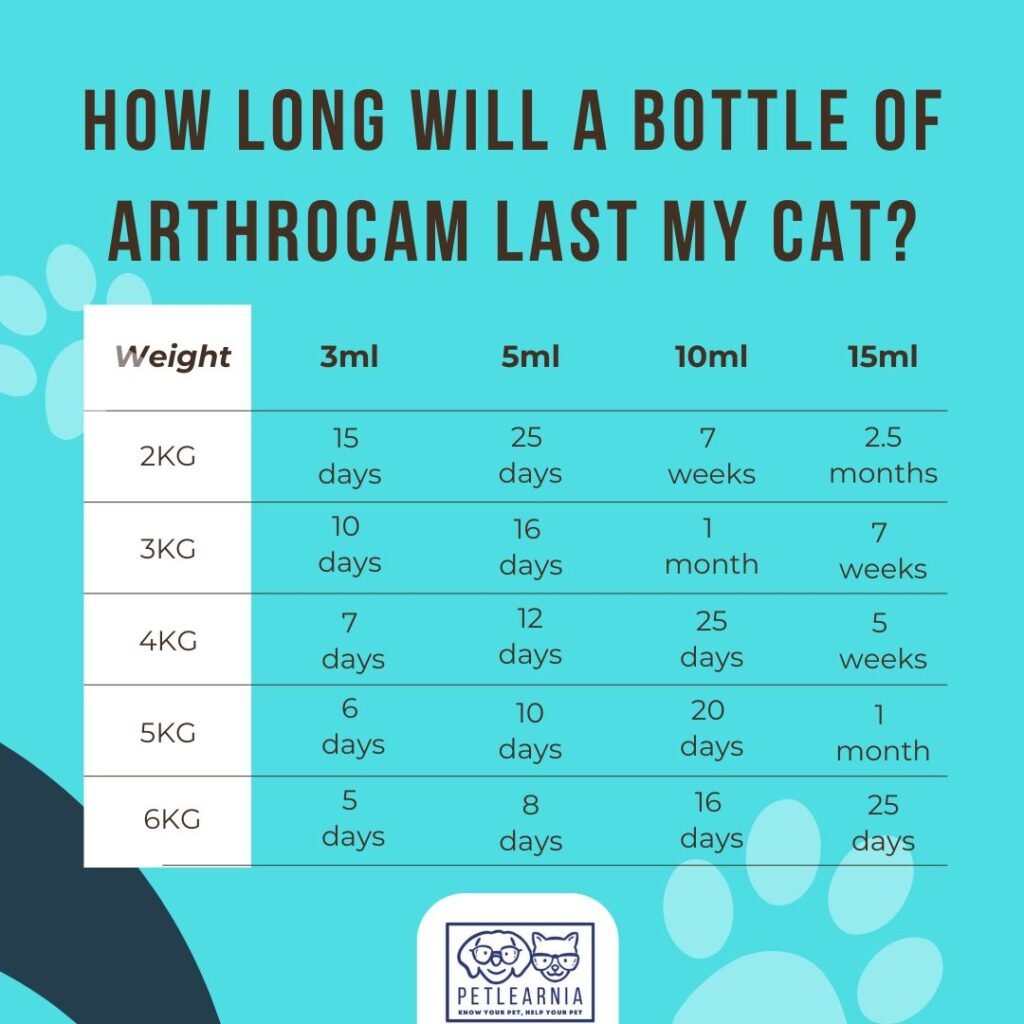Arthrocam for Dogs and Cats

Formulation
Liquid
Active ingredient
Meloxicam
Category
Pain relief / anti-inflammatory
What is Arthrocam?
Arthrocam is a brand name for a Non-Steroidal Anti-Inflammatory Drug (NSAID) called meloxicam. It’s commonly used in dogs and cats as a pain relief and anti-inflammatory. Arthrocam is a liquid – it’s given orally to help dogs and cats with pain.
Go straight to…
How does Arthrocam work?
Arthrocam works by blocking an enzyme called COX, which makes an inflammatory signal called prostaglandin H2. Prostaglandin H2 is responsible for causing swelling and pain in an area, as well as calling inflammatory cell types. By blocking COX, meloxicam helps reduce the production of these prostaglandins, and reduces the inflammation they encourage.
Interestingly, the meloxicam in Arthrocam blocks COX-2 – the pain and inflammation COX – while having a lesser effect on COX-1, another form of the enzyme that’s more involved in maintaining healthy functions in the stomach and kidneys. This selective action makes Arthrocam a good choice for managing pain and inflammation as it reduces the risk of side effects compared to medications that act on both COX enzymes equally.
What is Arthrocam for?
Arthrocam is often used in a number of situations where your pet is in pain, especially if they may also have inflammation. For example:
- Arthritis management: Given the name, it’s probably no surprise that Arthrocam is used in dogs and cats with osteoarthritis, helping to reduce inflammation in the joints and prevent them feeling too much joint pain.
- Post-surgery pain: After surgeries, Arthrocam is used to manage pain and reduce inflammation from cut skin and bruised muscles, joints, and organs.
- Injury relief: Arthrocam is used in a wide range of injuries, from cuts and grazes to strains and sprains. If your pet is limping, there’s a high chance they’ll be put on Arthrocam (or one of its alternatives.)
- Dental pain: Arthrocam is also used to relieve pain in pets with dental disease who are waiting for surgery, or for post-surgery pain relief for dogs and cats.
- Pain trial: In cats particularly, it can be hard to tell if they’re in pain. One good way is to give them pain relief for a while, then see if they improve. Stopping the pain relief is also a good option to test the theory that they’re painful somewhere – cats will often subtly deteriorate once they don’t have the pain relief, proving that they’re painful.
This list is not exhaustive – there are lots of situations where your vet may decide that Arthrocam is the best option for your pet.
Which pets is Arthrocam not suitable for?
Some pets shouldn’t have meloxicam (Arthrocam). These include:
- Pregnant or lactating animals
- Pets who are allergic to meloxicam or the other ingredients
- Cats or dogs less than 6 weeks old
- Cats with severe kidney problems, heart problems, or liver problems
- Cats with tummy and gut issues, especially blood in the vomit or stool
- Dehydrated animals or those with a low blood pressure
However, your vet might still recommend meloxicam in these pets if they feel it’s the best option for them. For example, cats with chronic kidney disease might still be prescribed meloxicam for arthritis so they can live pain-free. This is done as a risk-benefit analysis from your vet, so you should talk to them if you think your pet needs Arthrocam but is on the list above.
What are the side effects of Arthrocam in dogs and cats?
All medications can have side effects, and Arthrocam is no different. Side effects are generally rare when the drug is used properly. However, these side effects are known to be a problem with this drug:
- Digestive upset: Some pets taking Arthrocam might get vomiting, diarrhoea, or a loss of appetite. Current evidence suggests this happens in less than 1 in 10,000 cats and dogs, but most vets have seen this side effect and it may be more common. If this happens, you should stop giving the Arthrocam and call your vet. You should particularly look out for bloody vomit, bloody diarrhoea, or black, tarry stools in pets on Arthrocam – these suggest ulceration of the gut and can be an emergency.
- Liver problems: In very rare cases (less than 1 in 10,000 cats and dogs), there can be rises in liver enzymes that suggest liver damage is occurring. If Arthrocam is used long-term, your vet may recommend regularly testing your pet’s liver function to watch for this side effect.
- Kidney problems: Kidney failure is a possible side effect of Arthrocam, although it is rare- affecting less than 1 in 10,000 treated cats and dogs. In some cases, Arthrocam may make existing kidney problems worse, which is why your vet might recommend a blood test before and during Arthrocam treatment.
- Changes in behaviour: Keep an eye out for any changes in your cat or dog’s behaviour or activity levels. Lethargy affects less than 1 in 10,000 treated pets.
- Allergic reactions: Though not common, allergic reactions can occur. Signs to watch for include skin irritations, itching, or swelling, especially around the face.
Remember, this list doesn’t include all possible side effects, and most pets won’t experience any of these. However, if you notice any side effects or if your cat or dog still seems uncomfortable after taking Arthrocam, it’s always best to contact your vet right away.
Not only will your vet suggest changes to your pet’s medications if needed, they also have a duty to report the side effect (known as a Suspected Adverse Reaction) to the Veterinary Medicines Directorate (VMD). The VMD monitors and investigates these reports and can remove the drug’s license or force a change in the drug’s listed side effects if they spot trends.
As a pet owner, you can also report a suspected side effect to the VMD if you think Arthrocam caused problems for your pet. Or, read our article for more advice about reporting suspected pet drug side effects to the VMD.
How to give Arthrocam safely
As with all medicines, it’s important to use Arthrocam safely. There are a few things you can do at home to reduce the risk of side effects from Arthrocam in your pet:
- Follow vet instructions: Always use Arthrocam exactly as your vet has prescribed. This includes the right dose and frequency of doses. Never adjust the dose on your own, even if your dog or cat seems to be feeling better or worse. If you aren’t sure of the dose prescribed, please call your vet to confirm.
- Only use the syringe provided: The syringe provided with Arthrocam is a special syringe. For ease of dosing, the numbers on the side correspond to your pet’s weight. This means that the ‘5’ on the syringe is for 5kg, not 5mls, and giving 5mls would be a huge overdose. If you lose the syringe that comes with the Arthrocam, call your vet and arrange to get a spare. Do not use a syringe from a different brand or product as this could lead to the wrong dose being given.
- Syringe size (dog Arthrocam only): Arthrocam for dogs comes with two syringes – one for accurate dosing of dogs under 20kg and the other for accurate dosing of dogs 20-60kg. Your vet might remove the unnecessary syringe but if they do not, you should choose the most appropriate syringe for your dog’s size.
- Shake the bottle: Arthrocam is a suspension of powder in a liquid, which means the drug may settle over time and become uneven in the bottle. Make sure you shake it before drawing up the dose.
- Give with or after food: It’s safest to give Arthrocam on a full stomach as this reduces the side effects of meloxicam. You can either put it on your pet’s food or syringe it directly into their mouth after they’ve eaten.
- Check with your vet if giving anything else: Your vet should be aware of other drugs your pet is on, but it’s always worth double-checking in case there’s been a miscommunication somewhere. If your dog or cat is on supplements or non-prescription treatments (even if these are herbal) you should also tell your vet when they prescribe Arthrocam, as they may not be suitable to be given together. For example, turmeric (often given for arthritis) can cause problems when given with NSAIDs like Arthrocam.
- Report any accidental overdose to your vet immediately: If you have mistakenly given too much Arthrocam, speak to a vet as soon as you realise the error. They may recommend blood tests, intravenous fluids, or monitoring, depending on the severity of the overdose.
How much monitoring do pets need on Arthrocam?
If your pet is on Arthrocam for less than two weeks, it’s unlikely they’ll need to have blood tests. However, if your vet is intending Arthrocam for long-term use, they’ll usually recommend a blood test before the medication is started. They’ll also recommend regular blood tests, usually every 6-12 months depending on your pet’s age and condition.
What does Arthrocam cost?
The cost of Arthrocam depends on the size of your pet, but it can be as little as £12 per month. Remember to include prescription, dispensing and postage costs when comparing costs to buy Arthrocam online.
You don’t have to buy Arthrocam from your vet, but if you choose to buy it elsewhere your vet will need to give you a written prescription. Vets are allowed to charge a reasonable fee to cover their professional time checking doses and writing a written prescription for use elsewhere.
Arthrocam FAQs
How quickly does Arthrocam work?
Arthrocam usually works within 1-2 hours. If you’re still seeing signs of pain after 2 hours, you should contact your vet or advice, as additional pain relief may be needed.
Is it better to give meloxicam morning or night?
It’s up to you whether you give Arthrocam in the morning or at night – the most important thing is that meloxicam is given alongside a meal or on a full stomach. It’s also important to give it at a time you’ll remember.
If both morning and night work equally well for you, then morning might be slightly better- your dog or cat gets the full benefit of the medication while they’re awake during the day, and it starts to wear off as they’re asleep and don’t need it as much.
Can I buy Arthrocam without a veterinary prescription?
Like all meloxicam products, Arthrocam is a prescription-only medication in the UK and can’t be bought over-the-counter. Even if you’ve used Arthrocam before, your vet will need to examine your pet in order to prescribe Arthrocam. You can then buy your Arthrocam from a vet or from a licensed dispensing pharmacy, including an online pharmacy. Please note that there are no over-the-counter pain relief drugs for pets in the UK.
What types of Arthrocam are available?
Arthrocam comes as a liquid solution, in two concentrations – the 0.5mg/ml concentration is for cats, while the 1.5mg/ml concentration is for dogs. It’s very important to make sure you are giving the right concentration for your pet’s species, and you should check this whenever you get a new bottle.
Arthrocam comes in 15ml, 42ml, 100ml and 200ml bottles (dog version) and 3ml, 5ml, 10ml and 15ml bottles (cat version).
How long does a bottle of Arthrocam last?
When buying a bottle of Arthrocam, you want to know how long it’s going to last your pet. How long a bottle of Arthrocam lasts depends on your pet’s weight (which changes their dose) and the bottle size you purchase. Because it can be a bit complicated, we created a handy chart to show how long a bottle of Arthrocam will last your pet.

Arthrocam Alternatives
If Arthrocam isn’t suiting your pet or is no longer available, there are lots of alternatives. There are lots of alternative brand names of meloxicam that may work for your pet:
- Liquids: Inflacam, Rheumocam, Metacam, Chanoxidyl, Animeloxan, Melosus, Meloxaid, Meloxidyl, Meloxoral, Meloxyl, Metaxx, Movocam
- Tablets: Inflacam (pork flavoured), Rheumocam (pork flavoured), Lemicam (unspecified flavour),
If meloxicam (like Arthrocam) isn’t suiting your pet, your vet might recommend a switch to another NSAID with a different active ingredient. In cats, the only other licensed NSAID is Onsior. Dogs have several options:
- Carprofen (Rimadyl, Dolagis)
- Firocoxib (Previcox)
- Cimicoxib (Cimalgex)
- Grapiprant (Galliprant)
- Robenacoxib (Onsior)
If Arthrocam isn’t fully controlling your pet’s pain, your vet might recommend starting another medication alongside it. They might recommend exploring:
- Tramadol (Tralieve, Tramadog, Tramalgesic, Tramtab, Tramcoat, Tramsan, Tramvetol)
- Gabapentin
- Amantadine
- Buprenorphine
- Ketamine injections
They might also recommend complementary therapies alongside, like laser therapy, physiotherapy, hydrotherapy, or anti-inflammatory supplements.
Arthrocam Datasheet
All drugs have a manufacturer’s datasheet, which gives information about the drug’s use and possible side effects. There is usually one in your Arthrocam box, but if you have lost it you can click on the button below to be taken on an online version.
More help for your painful pet
If your pet is on Arthrocam for pain relief, you want to do everything you can to help. Our courses have been written by vets to help pet owners learn about their pet’s condition and how to help their pets holistically. The following courses may be helpful if you’re concerned your pet is in pain:
Please note that the information contained herein is provided for informational purposes only. Although it has been written by a vet, we cannot consider the individual nature of your pet’s problems so it does not constitute veterinary advice. If you have questions about your pet’s medication or their health you should contact a vet, who will be able to help.
- Why Do Dogs Sleep So Much? A Vet Explains What’s Normal (and What’s Not) - March 27, 2025
- 10 Signs Your Dog Needs Probiotics – Vet Explains When to Supplement - March 14, 2025
- The dog gut microbiome explained (by a vet) - March 10, 2025







